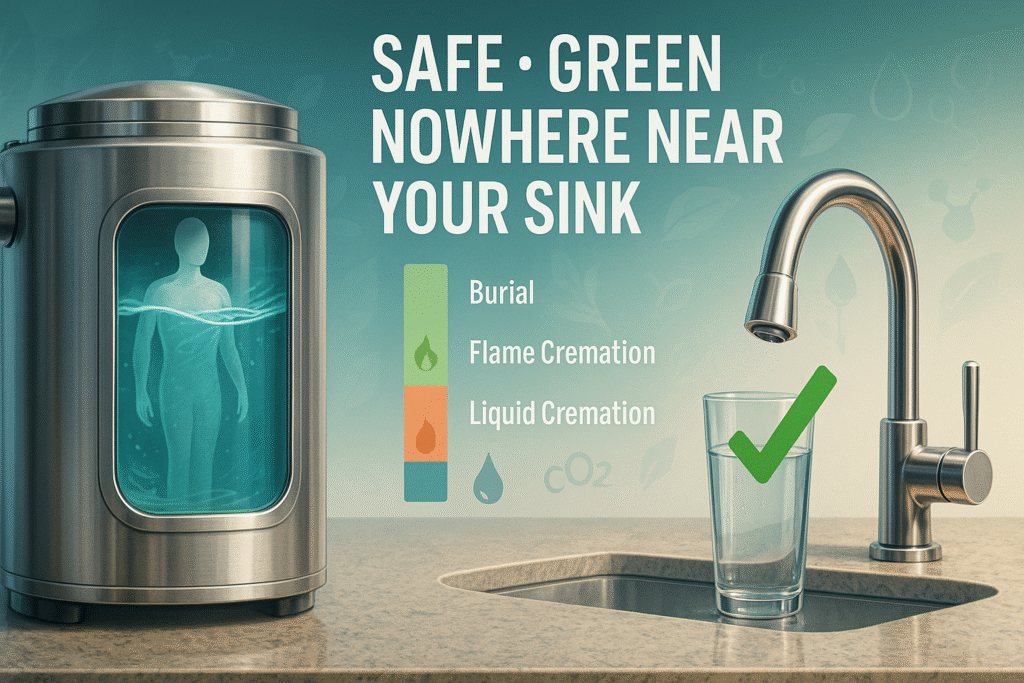
“The Truth About ‘Liquid Cremation’: Safe, Green, and Nowhere Near Your Kitchen Sink”.
Why You’re Hearing About “Liquid Cremation”
Over the past two years, social-media rumors have claimed that alkaline hydrolysis (nicknamed water or liquid cremation) sends “dissolved bodies” into the public drinking supply. Those claims are fiction. This article separates fact from clickbait so you can decide—without fear—whether aquamation belongs on your short list of eco-friendly end-of-life options.
What Actually Happens Inside the Vessel
- Warm water + alkali (≈ 95 % H₂O, 5 % potassium or sodium hydroxide).
- Gentle heat & pressure (≈ 200 °F, 60 psi).
- Natural chemistry accelerated: soft tissue breaks down into basic organic building blocks.
- Outcome
- Sterile liquid (pH-11 → neutralized at drain, per local sewer permits).
- Pure white bone mineral, dried and returned to the family just like cremated “ashes.”
EPA position: “No evidence suggests waste from alkaline hydrolysis has entered or could enter municipal drinking water.”
Where It’s Legal (and Growing)
| Status | States | Year-First Adopted |
|---|---|---|
| Legal today (28) | AL, AZ, CA, CO, CT, FL, GA, HI, ID, IL, KS, ME, MI, MN, MO, NC, ND, NV, OK, OR, TN, UT, VA, VT, WA, WV, WI, WY | 2003-2024 |
| Pending bills (6) | MD, NY, PA, SC, TX, VA (expansion) | 2025 sessions |
(Sources: CANA legislative tracker; US-Funerals Online; WorldPopulationReview).
How Green Is It?
(Kg CO₂ released per disposition, rounded)
| Method | CO₂ kg | Key Drivers |
|---|---|---|
| Conventional burial | ~250 | Concrete vault, lawn care, casket transport |
| Flame cremation | 534 | Natural-gas furnace at 1,600 °F |
| Aquamation | ≈ 54 | Low-temperature electric heat |
Common Myths—Busted
| Rumor | Reality |
|---|---|
| “It dumps liquefied remains into taps.” | Wastewater is sterilized, pH-balanced, and processed exactly like hospital effluent long before reaching treatment plants. |
| “Religions ban it.” | Only a few Catholic dioceses have expressed concern; most major faiths issue no prohibition. |
| “It’s untested.” | UCLA’s willed-body program has used the process since 2008 with peer-reviewed safety data. WIRED |
| “More expensive than cremation.” | Average U.S. direct aquamation: $1,995-$3,200—on par with flame cremation in most legal states. |
Real-World Safeguards
- Regulated vessels meet ASME pressure-reactor standards.
- Local sewer permits require neutralization to between pH 6–9 before discharge.
- Metal dental fillings are captured separately, preventing mercury emissions (a problem with flame cremation).
- State inspections parallel those for conventional crematories.
Why Families Choose It
- Climate stewardship (up to 90 % less energy).
- No flame imagery—viewed as gentler.
- Higher mineral return (≈ 20 % more bone powder for keepsake urns).
- Comparable cost to direct cremation, lower than burial.
Smart Next Steps
- Confirm legality in your state (CANA tracker).
- Tour a facility—reputable providers welcome questions.
- Request written price breakdowns just as you would for any disposition.
- Share this article to combat misinformation and help others make an informed, compassionate choice.
Written by a former funeral-home general manager turned consumer educator. All statistics verified May 2025.
